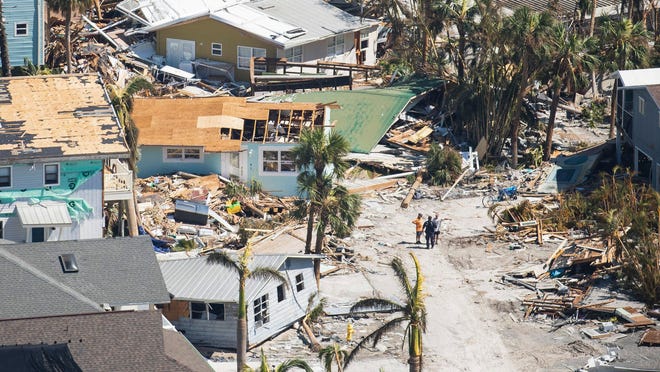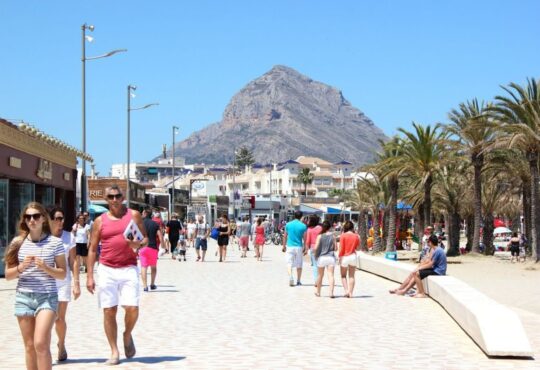
- As the effects of climate change grow more dire, danger is rising for Americans in floodplains, coastal marshlands, wildfire-prone areas and swaths of land struggling with drought.
- When disasters strike U.S. communities, taxpayers often pick up the tab.
- Some experts see a future where people slowly move away from higher-risk areas. Some think a more dire correction is coming.
More than a month has passed since Hurricane Ian struck the country, killing at least 119 and potentially causing more than $100 billion in damages. Many survivors are now facing a gut-wrenching question.
Should I stay or should I go?
In the aftermath of such natural disasters, residents and politicians alike often declare they will stay and rebuild. For Ian, that message is coming all the way from the top.
“The key here is building back better and stronger to withstand the next storm,” President Joe Biden said in September as he surveyed damage in Fort Myers, Florida, alongside Governor Ron DeSantis.
But inevitably, some residents will throw up their hands and walk away. Others plan to hedge, like Cindy Smith, a North Port, Florida resident who told a reporter she’d buy a mobile home after her home was flooded out by Ian. “That way I can flee,” she reasoned.
The question of what to do after disaster strikes is becoming increasingly perilous for the nation. For decades, many experts have warned that too many Americans are living in harm’s way: in floodplains and coastal marshlands, in mountainous terrain where the threat of wildfires looms, in desert landscapes vulnerable to drought.
Millions have continued to move to such areas anyway, and the costs to recover from major disasters now regularly reach into the billions of dollars, much of it paid for with taxpayer money. Once rebuilt, communities are often still vulnerable the next time water or fire reaches their doorsteps, costing billions more.
But with climate change bearing down, how much longer can the system hold?
In the aftermath of Ian, USA TODAY interviewed more than a dozen economic and environmental experts about how the changing climate is impacting where Americans live and what the future could bring. Some feel the status quo is likely to continue: the federal government effectively underwriting the costs of natural disasters, in part because cutting off relief funding remains politically unpalatable.
But others warned they see the nation headed toward a reckoning, if one hasn’t already begun. Costs are swiftly rising, cracks in insurance and real estate markets are showing, and risks of a potential 2008-style correction lurk.
“At some point, somebody will realize there are too many zeros in the costs,” said Mindy Lubber, CEO of Ceres, a Boston-based sustainability nonprofit. “There just isn’t enough money to keep fixing things and rebuilding things.”

Even now, limitations are evident and not every community is made whole after a disaster.
More than seventeen years after Hurricane Katrina struck, New Orleans has yet to fully recover its population. The city’s demographics have also shifted, with fewer Black residents, replaced by a wealthier and whiter population in a city fortified by new levees.
The story is similar in Paradise, a northern California town nearly wiped off the map by the 2018 Camp Fire. As the town rebuilds, the more expensive cost of fire-resistant structures appears to be making Paradise “less affordable and less diverse,” researchers at the nearby California State University, Chico found.
In North Carolina, state transportation officials finally gave in to mother nature this summer and shuttered a coastal highway facing regular inundations of sea and sand. They replaced it with a 2.4-mile, $145 million bridge to connect key tourism communities on the Outer Banks. Meanwhile, cities like Kinston in downtrodden parts of the state continue to reel from the damages wrought by several hurricanes.

Experts say these kinds of under-the-radar stories of communities changed in the wake of disaster may prove to be the drumbeat of climate change. While a risk of precipitous collapse in populations and in real estate values remains one possibility, perhaps a more likely is a gradual erosion.
One by one, insurers go belly up, businesses relocate, government budgets strain and disaster-prone landscapes transform. Homeowners and communities with financial means or political connections fortify, while the vulnerable migrate.
Many who leave may not even comprehend that the planet’s changing climate led to their decision.
“The reasons that people move are always multifaceted. They rarely ever point to an environmental reason, even after a disaster happens,” said Linda Shi, an assistant professor in Cornell University’s city and regional planning department. “Friendship, kinship, livelihoods, stages of life, planning … all of these different things end up propelling people to make a decision to move.”

Costs growing from billions to trillions, with taxpayers on the hook
Looking across the country, many experts say there’s little indication of any large break in America’s build-destroy-rebuild habit. But others see cracks in the foundation as the economic burden deepens.
Since 1980 and adjusting for inflation, the U.S. has typically experienced about eight disasters each year that exceeded $1 billion in economic costs, data from the National Oceanic and Atmospheric Administration show. Over the past five years, the number has more than doubled to nearly 18 annually.
Total costs from those disasters have also grown. The yearly average used to be less than $50 billion. But 2005 made history as the first year to break $100 billion following Hurricane Katrina. Sandy did it again in 2012.
Now it’s happening nearly every year: 2017, 2018, 2020, and 2021 each eclipsed the $100 billion mark, as will 2022 should the estimates for Ian hold.
Much of these costs are now borne by taxpayers. Experts say insurance rarely fully compensates property owners. Over time, public disaster aid has sought to cover the gap. But it’s widening, leaving taxpayers on the hook for more.
More:Insurance and aid aren’t covering the cost of disasters in America. Is it time to relocate?
Prior to Katrina in 2005, the federal government used to pay for about 17% of hurricane damages. Now it averages 62%, according to a 2016 Congressional Budget Office report, including a high of nearly 80% for Hurricane Sandy.
Experts say that while it’s understandable to want to offer aid to fellow citizens following a disaster, it often exacerbates the problem by removing disincentives to build and rebuild in dangerous areas. Under this regime, key actors like lenders and investors bear little risk, warping the real estate market.
A 2021 study by Milliman, an international actuarial firm based in Seattle, modeled the financial losses that lenders should theoretically incur following a disaster. It found in the real world, they fared much better than expected after storms like 2017’s Hurricane Irma. The authors concluded that’s likely due in large part to federal and state programs providing a “significant buffer against credit losses.”
Another study found that in many cases, communities actually come out economically better off following a disaster, after copious amounts of public aid flow in and literally build the town back better. It all adds up to a lack of evidence that anything’s amiss.
“This risk is very large and it could be there, but it’s not in the historical data,” said Jonathan Glowacki, a principal and actuary at Milliman. “So it’s kind of like convincing people to diet and exercise. I know it’s good for me … But I’ve made it so far without really having to focus.”
![8/3/18 -- Santa Rosa, CA, U.S.A -- Santa Rosa resident Paula Lindsay, 56, who lost her home in the 2017 Tubbs wildfire, stands in a lot at the Oaks at Fountaingrove development that was leveled by fire. Rebuilding began with a year. [Martin E. Klimek, USA TODAY Network]](https://moneylowdown.com/wp-content/uploads/2022/11/335370e1-404b-4ebd-8ce2-2d4cc1349c8f-XXX_tdl_16__.jpg)
Researchers at the Brookings Institution, a Washington, D.C.-based think tank, analyzed credit agencies and investors and found they held a pervasive belief that the federal government will continue to finance disasters, providing a key justification not to price climate risk into their calculations.
That allows insurance premiums and interest rates for building in disaster-prone areas to remain lower than they would otherwise and opens the door for populations to keep piling into dangerous areas.
With the country quickly moving into uncharted fiscal territory, some wonder just how long government can continue to underwrite the system.
Total federal payouts have reached at least $593 billion since 2005, much of it through the Federal Emergency Management Agency. An agency projection of $160 billion in disaster aid over the past two years alone “[Dwarfs] any previous two-year period in [the program’s] history,” William Painter, an emergency management specialist at the Congressional Research Service, told a panel last year.
Other research has found such figures may actually only be the tip of the iceberg. In a 2017 study, Tatyana Deryugina, an environmental economist at the University of Illinois, calculated that federal costs following some hurricanes are five-to-seven times larger than what’s accounted for by FEMA, after factoring in social welfare programs like unemployment and medical expenses for victims. That would mean accumulated costs to taxpayers may well have reached into the trillions over the past two decades.

If the costs haven’t already breached that threshold, it’s only a matter of time.
Last year, Brookings researchers calculated what would happen if the disasters of today occurred under the expected climatic conditions at the end of the century. In that world, they estimated, annual FEMA payouts could rise a thousand-fold, reaching into trillions of dollars just for coastal cities like Miami and New York, let alone the rest of the country.
While federal bailouts for disaster-prone communities, “Might have been tolerable in an era of modest impacts from natural disasters,” researchers concluded, “That era is ending.”
Inequity the hallmark of change
Anyone looking for an inflection point need not look decades into the future. Changes are happening now.
Prior to Katrina, the population of New Orleans was 494,000. That dropped by more than half after the storm and has since only risen back to about 377,000, Census data show. There are bright spots: pockets of the city like the Central Business District have recovered, home prices in many neighborhoods are booming, and suburban growth has pushed the population of the overall metro area back to pre-Katrina levels.
But as The Times-Picayune/The New Orleans Advocate reported last year, the recovery is unequal. Four public housing complexes in the city were torn down for lower-density development. Mom-and-pop rental units never came back. There were inequities in government payouts for shuttered homes, the paper reported.
The overall effect is a whiter city. Black residents were more likely to be cast out in diaspora, and wealthy residents moved in and drove up real estate values. In turn, that forced even more long-term residents out.
“The recent outmigration now appears to be driven by low-income workers who can no longer afford to live in the city,” the paper concluded.
![Two sections of new floodgates are shown in the down position in New Orleans' London Avenue Canal during a demonstration near the city's central business district. The gates reduce the strain on the levee walls from surges of water from Lake Pontchartrain. [Bill Haber, Associated Press]](https://moneylowdown.com/wp-content/uploads/2022/11/29e99652b857bd4fe1ac559537da149b.jpg)
Inequity is a hallmark of many post-disaster recoveries, and one that could increasingly dominate the landscape as climate change bears down. The logic is straightforward: after a storm, some people have the means to stay, while others don’t. Often, the wealthier group can also use its resources to better access government relief, furthering the divide.
“What’s going to happen is that the communities that are organized and capable are going to fight back,” said David Victor, a professor of innovation and public policy at UC San Diego. “And lower income communities and places already on the edge are going to empty out.”
The aftermath of the Camp Fire, which devastated Paradise in 2018, offers a more recent example.
Following the fire, Paradise’s population dropped 83%, with many residents relocating to nearby Chico or fanning out across the country, researchers at CSUC found. As Paradise rebuilds, elderly residents on fixed incomes are conspicuously absent and diversity has dropped.
Insurance industry stretched
As more and more California communities face fates like Paradise, the state’s insurance industry is being pushed to the limit, driving up costs, exacerbating inequity and risking potentially catastrophic economic effects.
Seven of the top 10 most destructive fires in the state’s history have all come in the last five years. That’s led to billions in losses for insurers, who have tried to respond by raising rates or dropping coverage.
But that has brought them into conflict with state regulators, who are trying to keep consumer costs down and slow an enrollment surge in the California FAIR Plan, a public insurance pool for homeowners who can find no other coverage.
Experts say it’s a delicate dance. Neither state officials nor the insurance industry want providers to leave. But neither want to go bankrupt either. In the latest development, the state is trying to thread the needle by requiring insurers to offer a discount when residents fireproof their homes.
“California is an example of a market that’s on the brink,” said Nancy Watkins, a principal and actuary at Milliman.
In Louisiana, the state’s insurance industry is also in crisis after four hurricanes struck the state in the last three years. Ten providers have gone under. That’s saddled a state-chartered bailout program with 26,000 claims to pay out, which officials plan to finance through an unprecedented issuance of $600 million in bonds.
In addition, the Louisiana Citizens Property Insurance Corp., the state’s public insurer of last resort, has seen its policies grow from 36,000 to 102,000 in just two years. Regulators now seek a 63% rate hike, The Times-Picayune/The New Orleans Advocate reports.
Experts are now intently watching Florida to see if a similar fate will befall the state’s insurance industry in the aftermath of Hurricane Ian. In recent years, insurers were already stretched thin and homeowner premiums were on the rise due to past storms and associated fraud and litigation issues.
Jesse Keenan, a climate adaptation expert and professor at Tulane University, said he expects several companies to fail or exit the Florida market in the months ahead and place “enormous weight” on Citizens, the state’s public insurer of last resort. That would set up a battle between the state and insurance industry similar to the one taking place in California.
“It’s going to be a game of chicken,” Keenan said.
Benjamin Keys, a professor of finance and real estate at the University of Pennsylvania, agrees insurance troubles are where the “rubber meets the road.” And the situation in Florida underscores the fact that Americans in disaster-prone areas are running out of runway.
“We’ve had insurers bearing substantial amount of climate risk. And the question is how long can they continue to bend but not break?” Keys said. “All these paths suggest to me that eventually this burden is going to be borne by more than just insurers. You’re going to see effects in the market.”
A sudden collapse?
Some say this lineup of dominos looks familiar.
Nouriel Roubini, a New York University economics professor who predicted the 2008 financial crisis, sees climate change fueling a new bubble with exposure reaching throughout the country.
“There will have to be a massive migration from the south and the coastlines,” in the decades ahead, Roubini predicted in a recent Bloomberg podcast. “There’ll be trillions of dollars of real estate assets that are going to be damaged by essentially global climate change.”
Experts differ on the scale and likelihood of such a correction.
In 2007, economists say, the U.S. housing market was overvalued by about $8 trillion, as mortgage providers and homeowners overextended themselves financially. By comparison, Milliman calculates that current unaccounted for flood risks equate to about $520 billion in overvaluation of homes, primarily concentrated in coastal counties.
But floods aren’t the only risk. Wildfires are increasing across the west. With some storms, wind can cause nearly the same level of damage as flooding, even to inland areas. And drought and extreme heat may stress traditionally fast-growing metro areas like Phoenix.
“The really pernicious threat here is heat. That’s what’s a real killer,” Victor said. “Communities will empty out.”
Calculating the total economic risk is challenging, if not impossible. Experts say that’s partly because climate change is a relatively new threat that financial institutions have not had to account for in the past. There is now an arms race taking place among insurers and lenders to develop new technologies to accurately predict disaster risk and future conditions.
In a 2021 report for the nonprofit Research Institute for Housing America, researcher Sean Becketti concluded that at present, “The ability to quantify climate risks is likely to fall short of the existing standards” for determining traditional risks to lenders, metrics like the credit scores of buyers.
Government role is key
But perhaps the most significant uncertainty in how the economic risks of disasters will play out is what government does next. Many who doubt a significant change is coming say that’s largely due to a belief Congress will never choose to stop underwriting the costs.
“Congress wants to do things for people, and people after disasters are in need,” Victor said.
But Victor says that adds a “moral hazard” in actually encouraging people to move into disaster-prone areas and risking further death and destruction.
History shown little indication of a change in course.
Between 2010 and 2020, the population of nearly 90% of the 225 coastal counties in the nation grew, a USA TODAY analysis found — a total increase of about 7 million people. Some, like St. Johns County in northeast Florida, saw population jumps of 40% or more over the decade.
More:Climate change makes living at the coast riskier. But more people keep coming.
Because few private insurance companies offer flood insurance due to the high levels or risk, the vast majority of flood policies in such coastal areas are issued through FEMA’s National Flood Insurance Program. Experts say the program has historically underpriced premiums, leaving it billions in debt ever since the devastation of Hurricane Katrina.
In 2012, Congress passed legislation to fix the problem, but gutted it just two years later after facing a political backlash over increased costs to homeowners. In 2017, lawmakers instead wrote off $16 billion in debt to the flood insurance program. Today it still remains approximately $20 billion in the red, according to the Congressional Research Service.
“There’s good reason to be pessimistic about our ability to get the incentives for development in high-risk areas correct,” Deryugina said. “Even trying to phase them in slowly may be met with a lot of resistance, so it seems like lawmakers have quietly given up trying.”
But others say they see signs of change coming from the executive branch during both the Trump and Biden administrations.
Less than a year before Ian struck, FEMA adopted consequential updates to the way its flood insurance program assesses risk, with the effect of adjusting rates on millions of policyholders across the country. While many homeowners saw their rates decrease, those in areas of substantial risk saw steep increases.
More:Flood-prone homeowners could see major rate hikes in FEMA flood insurance changes, new study finds
FEMA has also proposed a rule that would tighten the criteria for states to obtain a federal disaster declaration and access to relief funds. The agency, along with other government programs and the 2021 infrastructure bill, is spending more money to buy out properties in hazardous areas and restore natural defenses.
“We’re not seeing a line drawn in the sand to not rebuild in certain areas,” said Laura Lightbody, project director of the Pew Research Center’s Flood-Prepared Communities initiative. “Though there is over the past five years or so, the most investment by the federal government in mitigation we’ve ever seen … buyouts of properties, using nature-based solutions, putting in living shorelines.”

The agency told USA TODAY it budgeted a “historic” $3 billion in spending for such mitigation efforts in 2022 and also adopted a new building codes strategy to “advance the adoption and enforcement of hazard-resistant building codes and standards” in agency work.
In line with independent analysis, the agency says it expects climate change to continue to increase costs, although it may fluctuate from year to year.
“That’s why FEMA and the entire Biden-Harris Administration are using every lever at our disposal to ensure that we are better prepared for the threats we face today, along with the ones that will come tomorrow,” FEMA press secretary Jeremy Edwards said via email.
Elsewhere in the federal government, the Securities and Exchange Commission is working on a rule that would require financial institutions to disclose climate-related risks, which experts say could help correct market distortions by discouraging investors from placing their money with entities holding copious amounts of flood or fire risk.
And perhaps most significant are Fannie Mae and Freddie Mac, federally-backed mortgage companies whose $7 trillion in holdings represents 60% of U.S. mortgage debt. As Freddie and Fannie typically do not assess disaster risk to properties when deciding whether to purchase their mortgages, analyses have found they often serve as a dumping ground for private lenders to offload mortgages for fire or flood-prone properties.
Officials at the Federal Housing Finance Agency, which oversees Freddie and Fannie, have acknowledged the problem and last year held listening sessions on how to address climate risks. Keenan believes change is coming.
“Fannie and Freddie are extremely active in this area,” Keenan said, adding he, “Fully anticipates that a top-to-bottom transactional system for climate risk assessment is going to be rolled out, probably in the next year or two.”
Change inevitable?
Regardless of whatever steps policymakers and Congress take next, experts see signs some markets are already starting to move on their own.
In a study published last month, Keenan and colleagues found evidence that businesses are relocating from Tampa Bay to inland communities on higher ground, snatching up cheap land in lower income neighborhoods, which Keenan labels “climate gentrification.” If trends continue, the dynamic could drive substantial migration and displacement.
“A lot of businesses are not stupid … they’re much more sensitive to banking and lending and credit constraints and other things than consumers are,” Keenan said. “They’re going to take jobs with them, they’re going to take taxes with them, they’re going to take a lot with them.”
In turn, Keys’ research has found modest corrections on the prices of high-risk Florida homes. By studying coastal Florida communities most at risk from sea level rise, he and researcher Philip Mulder found the resale value of homes had dropped more than 5% by the end of 2019, compared to those in less-at-risk communities. Such changes could snowball as seas continue to rise and storms like Ian drive up insurance rates and test the market’s financial underpinnings.
Even those optimistic about the resiliency of markets on the Florida coast believe some level of change is inevitable.
Shahid Hamid, finance department chair at Florida International University, says he himself was drawn from Maryland by the state’s promise of blue seas and bright sunshine. Following a preliminary post-Ian analysis of the Citizens program and the state’s insurance industry, Hamid believes the overall system has enough resources to endure Ian, particularly if legislators solve the fraud and litigation problem.

Longterm, Hamid believes the allure of Florida will continue to attract buyers who can engineer homes to better withstand winds and rising seas. But he says that would mean homes will look different and be more expensive to build. Added to the rising costs of insurance, the prospect raises fresh questions about who will ultimately be able to afford living there.
“If you want to live in so-called paradise,” Hamid said. “You have to be willing to compromise.”
Kyle Bagenstose covers climate change, chemicals, water and other environmental topics for USA TODAY. He can be reached at [email protected] or on Twitter @kylebagenstose.





